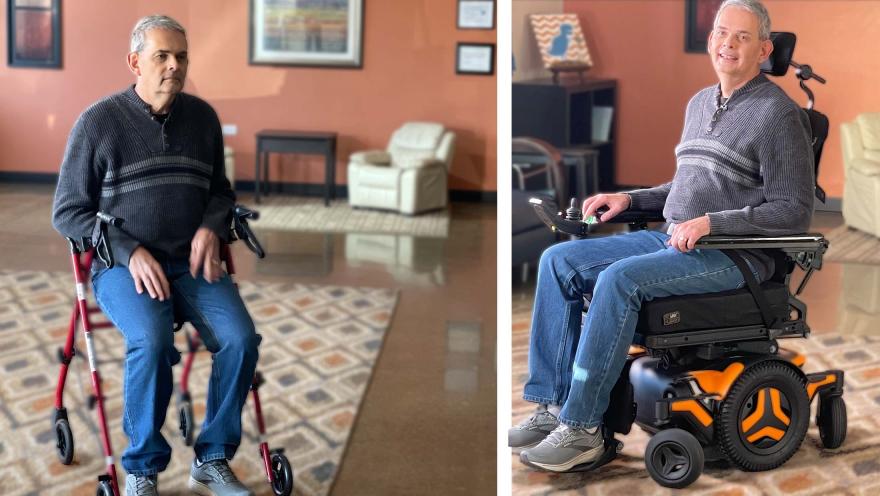This is the second in a four-part series highlighting a new Association video series exploring mobility changes people living with ALS face, created to help initiate discussions between individuals living with the disease, their family members, and their care team, and to assist families with planning and informed decision making.
Finding ways to remain independent and prevent potential harms caused by everyday living activities can be a challenge for people living with ALS as their disease progresses. To help address the many questions and concerns people and their families often have, The ALS Association has developed a series of educational videos to introduce and explain strategies to remain safe while living with the disease.
“Decreasing mobility is a challenge faced by every person living with ALS at some point in their disease journey, and many times we find people just don’t know where to begin or even what questions to ask,” said Leslie Ryan, senior director of education and professional competencies at The ALS Association. “As part of our new video series, we spoke with experts in the field who are able to help educate the families we serve and provide options for planning and anticipating change throughout the process.”
Diagnosed with ALS in 2020, Ellen Alires-Trujillo sat down with mobility equipment specialist, Michele Longo, to learn more about the mobility challenges ahead and strategies to help her remain comfortable and independent for as long as possible.
Ellen, who enjoyed an active lifestyle prior to her ALS diagnosis, had numerous questions about the progressive muscle weakness caused by ALS and the interventions available to help her remain independent. “How do I know what kinds of apparatus or what I should be using so that I can continue to be as mobile as I possibly can?” Ellen asked.
While freedom of movement – walking, going up and down stairs, completing daily activities, exercising—become difficult or even impossible to do after an ALS diagnosis, there are a variety of different pieces of equipment to consider throughout the stages of disease progression. From various types of canes and walkers to scooters and wheelchairs, there are numerous options available to help maintain balance, prolong independence, and provide comfort and support while conserving energy and keeping you safe from falls.
As ALS progresses, the need for heavier equipment is often necessary to make up for the loss of strength and more complicated custom equipment is required for comfort and safety. Michelle explains, “First of all, planning is really important, and planning ahead is important as well because getting this equipment gets more complex. Getting a cane, a walker, what we might call a ‘lower end’ or ‘more simple’ piece of equipment can be very quick,” she said. “But getting something that's individually customized for you as a piece of mobility equipment is a very involved process and it can take longer.”
Michele advises starting with an evaluation by a therapist, the wheelchair provider and a neurologist or other health-care provider. “They're going to do strength mobility testing. They're going to be talking about what the needs are and they're the ones that are really justifying what level of equipment you need, and why you need that level of equipment,” she explains.
After the evaluations are complete, the equipment provider will gather all of the detailed documentation required and present it to the patient’s insurance carrier to determine the level of financial coverage they have. Once approval and funding by the carrier is processed, the equipment specialist provides the patient with the accepted options available along with any additional costs or copays they may be responsible to cover.
After the specifications for the wheelchair are agreed upon and the order placed, the equipment typically arrives within a few weeks. At that point, Michele describes the final steps in the process. “We get you in, we're going to fit it to you, make sure it works, make sure that you know how to use it, give you all the instruction you need,” she said. “Because it is, I should say, pretty high tech and we want to make sure that you're comfortable and safe.”
Ellen’s husband and caregiver, Lorenzo, is eager to better understand the process and options available from a caregiving perspective. “I'm a caregiver, and we're getting a motorized wheelchair and it raises many questions for me in my household,” he said.
For caregivers like Lorenzo, ongoing support is available from the local ALS clinic team and equipment provider, including education, advice and training on use of the wheelchair. “It is important that both you and your wife know how to use the chair,” Michele said.
Lorenzo’s primary concern was how he could help and support his wife. “This is all new for me,” Lorenzo told Michele.
More in-depth information is listed with each video, and we strongly encourage you to follow up with your local chapter and clinic team for more information. To continue to learn more about ALS and follow stories about people living with the disease in the community, follow our blog at ALS.org/blog.


Comments
Very helpful. I am receiving a scooter tomorrow to augment and ultimately replace my Nitro rollator. The Steven Hawkings Rolls Royce is on the distant horizon. Very distant, I hope.
Join the conversation. Please comment below.